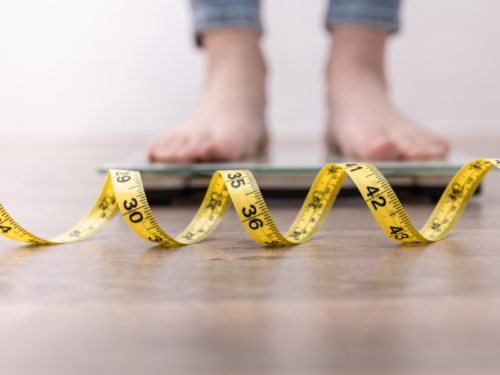
Table of Contents
Understanding the Link Between OCD and Eating Disorders

Written By: Ashley Laderer

Clinically Reviewed By: Mike Travisano
March 7, 2025
9 min.
Are you struggling with OCD, an eating disorder, or maybe even both? Keep reading to learn more about how these conditions are linked—and how to treat both.
Learn more about our Clinical Review Process
Table of Contents
Obsessive-compulsive disorder (OCD) and eating disorders are mental health conditions that can have major impacts on your quality of life and functioning. If you have OCD, your days might be filled with distressing obsessions and time-consuming compulsions. If you have an eating disorder, you might spend the majority of your time fixated on your body and engaging in restrictive eating, binging, or purging. If you have both disorders, the challenges are compounded.
Read on to learn about the similarities and differences between OCD and eating disorders, their symptoms, how OCD can impact eating habits, and the treatment options available.

Treatment personalized to you
Virtual intensive therapy programs for serious mental health concerns.
Understanding OCD and eating disorders
At face value, OCD and eating disorders might appear very different, but when you take a closer look, there is a crossover. “Symptoms of OCD and eating disorders can commonly mirror one another and be difficult to discern between,” says Ashley Johnson, LCSW, a Regional Clinical Director at Charlie Health.
“There is also often a high rate of cross-diagnosis between the two conditions,” Johnson adds. “Having OCD or eating disorder increases the likelihood of having the other diagnosis when compared to the general population.” Research shows that up to one in five (18%) people with an eating disorder also have or have had OCD. To put this into perspective, the lifetime prevalence of OCD in the general adult population is only 2.3%.
To better understand the similarities and differences between OCD and eating disorders, here is a breakdown of each.
What are the symptoms of OCD?
OCD is when you have distressing obsessions (unwanted intrusive thoughts, urges, or images) and compulsions (repetitive behaviors carried out in an attempt to neutralize the anxiety caused by the obsessions or prevent something “bad” from happening). These compulsions can be mental––like ruminating, counting, or praying––or physical––like checking locks multiple times, performing an action a specific number of times, or excessive hand washing. The compulsions don’t bring pleasure, but they do temporarily bring a little bit of anxiety relief, which reinforces the OCD cycle.
If you have OCD, you likely have trouble controlling whether these obsessions pop into your head or the intense urge to carry out compulsions. To be diagnosed with OCD, you must also meet these criteria:
- You spend at least an hour a day engaging with obsessions and compulsions
- Your symptoms interfere with your functioning at home, work, school, or relationships
What are the symptoms of eating disorders?
Eating disorders are mental health conditions marked by an unhealthy relationship with food and disturbances in eating patterns. Most often, eating disorders are also linked to poor body image and a desire to look a certain way. Different eating disorders have different symptoms. Four of the most common eating disorders include:
1. Anorexia nervosa
If you have anorexia nervosa, you severely restrict how much you eat out of fear of gaining weight. Someone with anorexia might also exercise excessively for the same reason. Anorexia causes a very distorted body image, and you might view yourself differently than others do. Anorexia is often, but not always, connected to extreme skinniness.
2. Bulimia nervosa
Bulimia nervosa consists of cycles of binging and purging and a preoccupation with weight. Binging means eating a lot of food quickly in a short time, and purging means getting rid of the food by vomiting, using laxatives, or doing excessive exercise to avoid weight gain. Or, you might fast after a binge. There is often a lot of guilt and shame surrounding the behaviors.
3. Binge eating disorder
If you have binge eating disorder, you engage in binges where you eat an excessive amount of food quickly in a short period of time, even if you aren’t hungry. You may feel uncomfortably full, but still keep eating. There’s usually embarrassment and shame surrounding the behavior, which may lead you to binge in private.
4. Avoidant restrictive food intake disorder (ARFID)
If you have AFRID, you severely restrict what you eat –– but not due to body image or body weight concerns. Rather, those with ARFID have a strong dislike surrounding a food’s texture, smell, or appearance, for example. Or they might have fears linked to eating, like choking or throwing up. There may be an overall lack of appetite, malnourishment, and a limited amount of “safe” foods.
What are the key similarities and differences between OCD and eating disorders?
OCD and eating disorders are both linked to obsessions and compulsions. “In both OCD and eating disorders, the obsessions and rituals that develop can become all-consuming and have a strong impact on a person’s ability to engage in daily life,” Johnson says.
OCD obsessions can center around contamination, harm, sexuality, or really anything else that the brain latches onto as distressing. Compulsions can be any type of physical or mental act that reduces distress.
Eating disorder obsessions (and subsequent “compulsions”) are centered around weight and body image. “With anorexia and bulimia, anxiety associated with these obsessions of weight and body image can be lowered with the ritualistic acts of calorie counting, excessively dieting and exercising, and purging patterns,” Johnson says.

Typically, the key difference between OCD and eating disorders (particularly anorexia and bulimia) is the underlying motive. “Individuals with eating disorders have behaviors that are typically motivated by worries around body image and their physical appearance,” Johnson says. “Those who have eating rituals and compulsions with OCD may be driven by motivators that differ from body image and weight concerns.”
Additionally, OCD compulsions are carried out to lower the anxiety, fear, or worry connected to intrusive thoughts. In contrast, restricted behaviors related to eating disorders are carried out in an attempt to change weight or appearance, Johnson says.
What is the impact of OCD on eating habits?
People with OCD can certainly experience restrictive eating or compulsive behavior surrounding food –– but just because their eating habits may be unusual, it doesn’t mean they have an eating disorder.
For example, someone with anorexia nervosa may purposely skip meals because they have poor body image and fear gaining weight. They avoid eating to stay as thin as possible to achieve their “ideal” body. On the other hand, someone with OCD might avoid eating a meal because they are afraid that it’s been contaminated with dangerous germs, and they have severe anxiety about getting sick. This is strictly related to fear of contamination, not a desire for thinness or fear of weight gain.
There are many ways that OCD can impact eating habits that are not related to an eating disorder. According to Johnson, some examples include:
- Worry about having a harmful health reaction to a certain food
- Fear that a food may carry a disease
- Fear that something bad will happen if food isn’t prepared in a certain manner
- Fear of food prepared by a certain person
- Washing foods excessively due to fear of contamination
- Only eating certain types of foods believed to be more “clean”
- Chewing food a certain number of times due to needing things to be “just right”
- Touching or arranging food in a certain way as a compulsion in hopes of preventing a bad outcome from occurring
- Forgetting to eat due to engaging in time-consuming rituals and compulsions
Of course, someone can have both OCD and an eating disorder, and in these cases, behaviors surrounding food might be related to both OCD and an eating disorder.
What are the treatment options for OCD and eating disorders?
Seeking treatment is crucial for OCD and eating disorders, whether they are occurring alone or comorbid. OCD can take over your quality of life and functioning. Eating disorders can take a major toll on your health and, in the most serious cases, can even cause death.
Therapy is a key part of treatment for both types of disorders. In many cases, a blend of treatment modalities is used. “Medication management and family therapy can also be important components for treatment of those with OCD and eating disorders,” Johnson says.
OCD treatment options
Eating disorder treatment options
-
- Exposure and response prevention (ERP)
-
- Acceptance and commitment therapy (ACT)
-
- Inference-based CBT (I-CBT)
-
- Medication
-
- Cognitive behavioral therapy (CBT)
-
- Dialectical behavior therapy (DBT)
-
- Family therapy
-
- Nutrition counseling
-
- General doctors
-
- Medications
OCD treatment options
Evidence-based treatment options for OCD include the following.
1. Exposure and response prevention (ERP)
ERP –– a specific branch of cognitive behavioral therapy (CBT) –– is considered the gold standard of OCD treatment. In ERP, you will engage in exposures that purposely provoke your distressing obsessions, leading to an increase in anxiety. Then, you will actively resist engaging in your usual compulsions, allowing your anxiety to peak and lower on its own without your rituals. This is done alongside a trained ERP therapist. With time, you will learn that your obsessions are not dangerous. You’ll experience decreased OCD symptoms, anxiety, and a reduced desire to carry out compulsions.
2. Acceptance and commitment therapy (ACT)
ACT is an acceptance and mindfulness-based therapy often used alongside ERP. ACT can teach you to accept uncertainty and detach from your thoughts, including distressing obsessions. You will develop a non-judgemental attitude towards obsessions and intrusive thoughts. This therapy will help you determine your values and take committed action towards living in line with these values, not letting your OCD hold you back.
3. Inference-based CBT (I-CBT)
I-CBT is a newer approach to treatment, specially developed for addressing OCD symptoms. While traditional CBT is related to restructuring negative thoughts, I-CBT helps you recognize when you’re doubting reality or making harmful false assumptions. I-CBT will allow you to break free of obsessive rumination and “what ifs,” shifting focus to real-life evidence rather than imaginary fears.
4. Medication
In some cases, a therapist might refer you to a psychiatrist if they think you might benefit from medication. Medications can help reduce your symptoms and get you to a more manageable base level to better practice skills or exposures in therapy. Antidepressants known as selective serotonin reuptake inhibitors (SSRIs) are often first-line treatments for OCD. SSRIs FDA-approved for OCD treatment are:
- Fluoxetine (Prozac)
- Fluvoxamine (Luvox)
- Paroxetine (Paxil)
- Sertraline (Zoloft)
A second-line treatment is a tricyclic antidepressant (TCA) called clomipramine (Anafranil). It’s prescribed less frequently than SSRIs due to a higher risk of side effects.
Eating disorder treatment options
Various types of treatments can aid in eating disorder recovery. Common treatments include the following.
1. Cognitive behavioral therapy (CBT)
CBT is frequently used to treat eating disorders. This talk therapy helps you identify and challenge cognitive distortions (unhelpful, unhealthy thought patterns) related to your eating disorder. You’ll learn to develop healthier coping strategies to improve your body image and self-esteem while building a healthier relationship with food. Therapists may use a specialized form of CBT for eating disorders called CBT-E.
2. Dialectical behavior therapy (DBT)
DBT is another option for eating disorder treatment, especially for bulimia nervosa and binge eating disorder. DBT is a skills-based therapy focusing on emotional regulation, distress tolerance, mindfulness, and interpersonal effectiveness. With these skills, this form of therapy can help you reduce eating disorder symptoms.
3. Family therapy
Family therapy can help aid in treatment, especially for teens and kids with eating disorders. Family-based treatment can empower parents or other caregivers to aid their child in recovery, helping to re-establish healthy eating habits.
4. Nutrition counseling
Nutritionists are an important part of the treatment team for someone with an eating disorder, Johnson says. It’s crucial to work with an eating disorder-informed nutritionist or dietician, specifically. They can help you develop healthy eating habits and regain nutrition without reinforcing any disordered eating behaviors.
5. General doctors
Working with a medical doctor is also important to ensure medically safe care, says Johnson. Since eating disorders like anorexia and bulimia can cause a variety of physical health concerns, it’s important to ensure physical health alongside mental health. In some cases, such as severe anorexia, medical treatment might be necessary.
6. Medications
There aren’t many medication treatments for eating disorders. However, for someone experiencing comorbidity (co-occurring eating disorder and OCD or another disorder), medication can help reduce symptoms overall. There is no FDA-approved medication for anorexia. Two medications are FDA-approved for bulimia and binge eating disorder: Fluoxetine (Prozac) for bulimia and lisdexamfetamine (Vyvanse) for binge eating disorder.

How Charlie Health can help
If you or a loved one is struggling with OCD, an eating disorder, or both, Charlie Health may be able to help. Our virtual Intensive Outpatient Program (IOP) provides more than once-weekly mental health treatment for people who are dealing with serious mental health conditions, including OCD and co-occurring eating disorders.
We incorporate evidence-based treatments into individual counseling, family therapy, and group sessions. Additionally, we provide medication management when needed. With this kind of well-rounded treatment, you can find relief from OCD and eating disorders. Fill out the form below or give us a call to start today.
References
https://www.sciencedirect.com/science/article/abs/pii/S0165032720326975?via%3Dihub
https://www.nimh.nih.gov/health/statistics/obsessive-compulsive-disorder-ocd
https://www.ncbi.nlm.nih.gov/books/NBK519704/table/ch3.t13/
https://www.nimh.nih.gov/health/publications/eating-disorders
https://iocdf.org/about-ocd/treatment/erp/
https://adaa.org/sites/default/files/Grayson_157C.pdf
https://icbt.online/what-is-icbt/
https://pmc.ncbi.nlm.nih.gov/articles/PMC2928448/
https://pmc.ncbi.nlm.nih.gov/articles/PMC6897497/
https://jeatdisord.biomedcentral.com/articles/10.1186/s40337-022-00585-y




